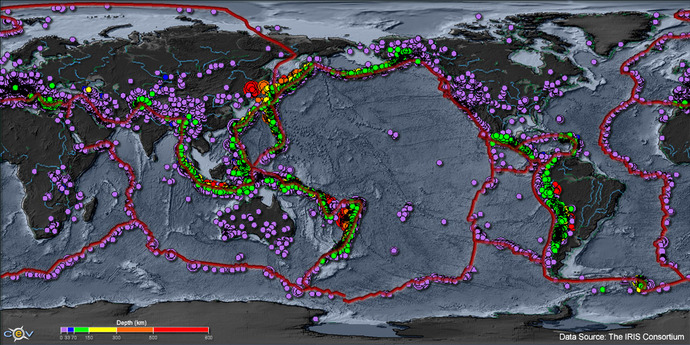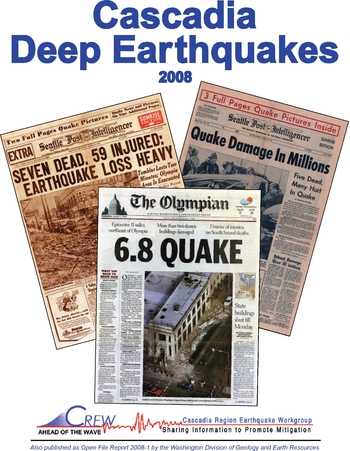Seismicity plays a critical role in shaping the face of our planet.
Seismicity plays a critical role in shaping the face of our planet, in creation of natural disasters, and in the past it has dramatically affected Earths' climate by perturbing gas hydrate deposits. The 2004 Sumatra tsunami generated by the Sumatra-Andaman earthquake (9.1-9.3 magnitude; ~ 300,000 people killed) and most recently the Sichuan earthquake (7.8 magnitude; 4.8 million homeless) in China serve as vivid reminders that our planet is dynamic and that earthquakes generate profound natural disasters resulting in significant human, economic, and property loss.
The OOI Regional Scale Nodes seismic array, coupled with seismic sensors deployed over the continental U.S. as part of NSF’s EarthScope program, make the Juan de Fuca tectonic plate an optimal place for researchers and educators to study seismic processes in real-time from the birth of the oceanic crust at spreading centers to its destruction within subduction zones.
The Pacific Northwest, where significant Ocean Observatories resources will be focused (i.e., the cabled OOI Regional and Coastal Scale Nodes), has experienced earthquakes similar to those in Sumatra and China as little as 300 years ago, and this region is believed to be overdue for a megathrust event. This is also an area with a culturally/educationally- rich history of legends and traditions rooted in the region's earthquake and tsunami events (e.g., Thunderbird and Whale). The catastrophic earthquake that occurred along the Cascadia Subduction Zone on January 26, 1700 is well documented in myriad tribal histories throughout Oregon, Washington, and Canada [1].
Enhancement of the OOI Regional Scale Nodes cable observatory to include an array of seismometers along the Pacific Northwest Coast could provide an early warning detection system for destructive submarine earthquakes and tsunamis in the region. Japan has long recognized the need for such a system - the estimated reconstructive cost for the Kobe earthquake alone was estimated to be $120 billion and significant loss of life occurred. Japan has now installed the Dense Ocean Floor Network System for Earthquakes and Tsunamis (DONET). This submarine cabled real-time seafloor observatory network is focused on establishing the technology for large-scale real-time seafloor research and surveillance infrastructure for earthquake, geodetic, and tsunami observation and analysis. The goal of this effort is to mitigate earthquake and tsunami disasters by rapid detection and data processing of seismic signals. Such a system could be invaluable in the Pacific Northwest were historical 9 magnitude earthquakes have occurred.
Although earthquakes as destructive processes (landslides, volcanic eruptions, tsunamis) are general knowledge, most of the public would be surprised to learn that, indeed, seismic processes are also important to generation of life itself. For example, in the deep sea, seismic events associated with underwater volcanoes at mid-ocean ridge spreading centers and within coastal accretionary margins result in the release of gases that serve as important energy and cell-building sources for microbes that thrive in the absence of sunlight. Some of these microbes are genetically the most ancient of organisms known on the planet and are capable of surviving at temperatures >120°C. Less than 1% of these organisms have been cultured and little is known about their metabolic activity, highlighting the fact that the ocean is still largely unexplored and that profound discoveries will be made at the interface of geological, chemical, and biological studies.
[1] Ludwin et al., (2005) Dating the 1700 Cascadia Earthquake: Great Coastal Earthquakes in Native Stories. Seismological Research Letters, 76(2), 140-148.








